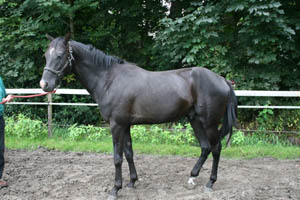 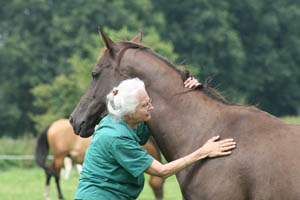 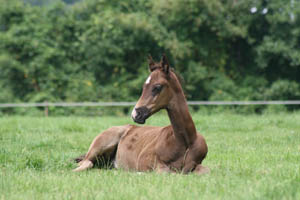 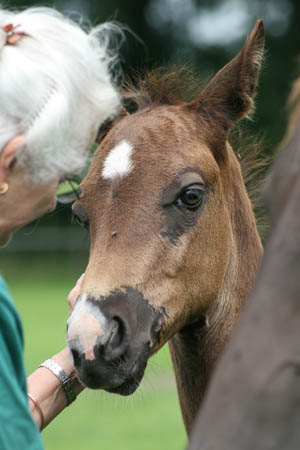 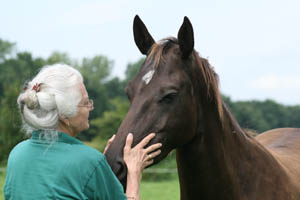 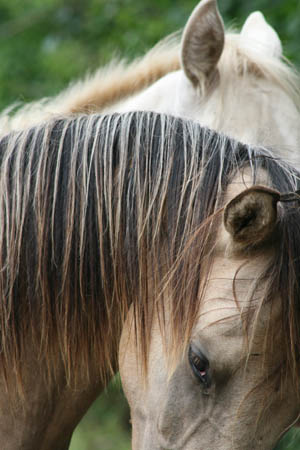 | ARGAMAK AKHAL-TEKE STUD Tuesday Aug 7 2007 Jeanne and Charles picked me up, and we drove an hour to De Wijk, Netherlands, where we met Janet and Rob Lam at the Argamak Studfarm of Akhal-Tekes, “Heavenly Horses,” the ancient Chinese called them, long before the advent of Western civilization. The name Argamak comes from Central Asia, and refers to the type of horse indigenous to that part of the world, including the Akhal-Teke. Janet is looking at buying another Akhal-Teke, and she wanted us to see the farm where she bought her mare Bugainvillia, that I'd seen at the Dutch endurance training weekend. The Akhal-Teke breed originated thousands of years ago (Alexander the Great's horse Bucephalus is reputed to have had Akhal-Teke blood) on the steppes of Central Asia, centered around today's Turkmenistan and northern Iran. The name of the breed changed over the centuries, but since the 1800's have been called Akhal-Teke: Akhal, from their centralized area of the Kopet-Dag mountains of Turkmenistan, and Teke, from the main people who bred them. The Akhal-Teke was bred namely for its qualities as a fast, hardened cavalry horse, and today carries those same qualities into a variety of horse sports, excelling in flat racing, dressage, jumping, eventing, and endurance - the Akhal-Teke is a good all around performance horse. In 1960 the Akhal-Teke stallion Absent won the Gold Medal for dressage at the Olympic Games in Rome. He won the silver and bronze medals at following Olympic Games, something no other horse has ever done. And just last week, an Akhal-Teke finished the Tevis Cup in America. While there are a variety of types – we could see several in her horses – they all have a distinctive long back and long neck that is carried high, are 15 and 16 hands, have a golden sheen to their coat, and have light gaits. The long body and long strides come from the fact they were bred for distance running and for spear combat – unlike the Arabian with the short, agile body that was bred for hand-to-hand combat. Their hooves are hard and tough, originating from the rocky steppes upon which they originated. The long neck with the high head carriage comes from looking far out over the steppes. Baronness Clara de Vos van Steenwijk, owner of the Argamak stud with her husband, showed us around her farm full of lovely Akhal-Tekes (and a few Warmbloods, which they used to breed) that they've been breeding for 8 years. The van Steenwijks lived in Russia for 6 years, and there fell in love with the Akhal-Teke breed. Why the Akhal-Teke? “Well,” said Clara, “I lived in Argentina as a child, did not grow up in Holland and so I was not used to the typical big broad Dutch Warmblood types, didn't have that feeling for them. My husband was riding English Thoroughbreds, and he wanted something a little more light. We'd heard about these Akhal-Tekes when we were in Russia, so we went to look at them, and we really liked what we saw. Everybody said they had good character.” The van Steenwijks brought back 6 Akhal-Tekes with them from Russia to Holland, 2 purebreds and 2 half-breds to start their stud with. While being a lovely lady who obviously loves her Akhal-Tekes, Clara is not just a hands-off breeder. She rides her horses for pleasure, and, at a young 70-something, she still gets on her youngsters for the first time! “But, only if I have help. It takes two people. I'm not going to get on one by myself.” (I was thinking, I'm only 40-something and I don't get on horses for the first time anymore!) Akhal-Tekes are known for their bonding friendship with humans and for being very loyal to one person. Indeed, all the horses Clara showed us came up to greet her and be petted, even the stallions. One mare kept touching her; when Clara stepped away, the mare put her head back against Clara's shoulder. You could see the pride in her eyes when she talked about each one of them, and the dedication she has to this breed – it was a pleasure to visit! See the Argamak Studfarm website at: www.akhalteke.nl |
Wednesday, August 8, 2007
Argamak Akhal-Teke Stud
Subscribe to:
Post Comments (Atom)
No comments:
Post a Comment